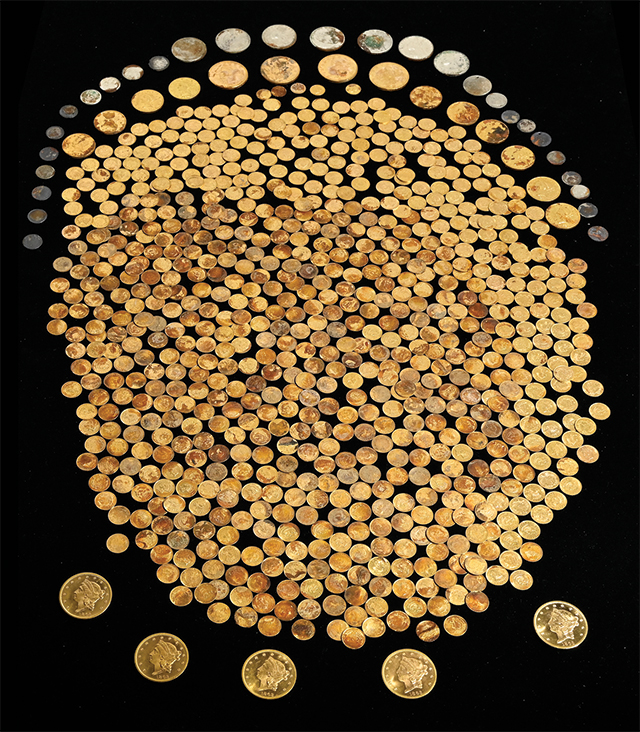


Kentucky man finds treasure trove of gold dollar coins worth hundreds of millions
Categories: Minting - Numismatics , Nálezy nejenom s detektorem kovů v USA, severní a jižní Americe
"This is the craziest thing ever: It's all $1, $20, $10 gold coins," the finder of an extremely valuable American Civil War-era treasure says in an excited voice in the video. The collection numbers over 800 coins in excellent preservation. A small portion are silver dollars, the vast majority are gold coins, including a rare 1863 Liberty Double Eagle and hundreds of U.S. gold dollars from 1850 to 1862. The hoard has been dubbed the "Great Kentucky Hoard", with a total value in the hundreds of millions...
The treasure was discovered on his own property by a previously anonymous finder who sold it to the numismatic auction company GovMint. The "Great Kentucky Hoard" also contains hundreds of American gold coins from 1840 to 1863. Each coin contains 90% gold and was struck at the Philadelphia, Denver, San Francisco, New Orleans and Carson City mints.
The coins were sent to the Numismatic Guaranty Company (NGC) for certification and grading. Once cleaned, the coins exhibited an eye-pleasing luster and were mostly in Extremely Fine to Mint State (XF-MS) condition. The XF coins probably circulated for only a very short time before being buried. Some of these coins may have been picked up at a bank and never circulated.
Probably the most amazing is the 1863-P Liberty gold $20 bill. The only such coin to be auctioned for a six-figure sum (in dollars), the "Great Kentucky Treasure" contains eighteen of them, almost all in XF-MS condition! According to NGC, the Liberty coins were minted by the Treasury Department after gold was discovered in California. These coins are even rarer because they do not contain the "In God We Trust" inscription, which came into use in 1866 after the Civil War ended.
At the time the hoard was deposited, America was in the throes of the Civil War. The people of Kentucky felt threatened, and many rich men were said to have buried vast sums of money in fear of the Confederacy. James Langstaff, for example, left a letter saying he buried $20,000 in coins on his property in Paducah. William Pettit buried $80,000 worth of gold coins near Lexington. Confederate soldiers quarantined for measles allegedly stole a payroll and hid it in a cave in Cumberland Gap.
Famed frontiersman Daniel Boone is said to have buried a cache of coins somewhere near his homestead in Fayette County, Kentucky. The infamous bandit Jesse James is said to have buried $50,000 in gold coins near Russellville, Kentucky, and his gang was said to have hidden the loot at various locations throughout the state of Kentucky. However, none of this treasure has ever been officially found.
Historical finds discovered on private property in the U.S. do not need to be reported to an archaeologist. It is always up to the landowner or the finder. However, it would be a shame if information about the site and the circumstances of the find were lost forever. According to experts, most American treasures and historical artifacts found on private land make it to the market or into collections without archaeological consultation. Such depots, meanwhile, carry a considerable amount of information, among other things, about the person who collected the objects. It thus offers archaeologists an interesting window into the past.
Video
Roman Němec
Sources: nypost.com, livescience.com, govmint.com

The Great Kentucky Treasure

Coins in situ

Gold and silver coins of the Great Kentucky Treasure

The coins have been cataloged, authenticated and will be offered for sale at auction
The article is included in categories:
- Archive of articles > Minting - Numismatics
- Archive of articles > Archaeology > Finds and rescue research abroad > Nálezy nejenom s detektorem kovů v USA, severní a jižní Americe
Post
Tady asi někdo začne skupovat pozemky v okolí Kentucky. Prostředky mít bude.. 
Nádhera největší ✌️💪👍👍👍
Ku.vafix, to je teda náááářez.... 


Bůh žehnej Americe !
U nás by nedostal nic a ještě by mu zabavili detektor.
Nebo když by měl s sebou psa a sved to na něj, tak dostane maximálně půl milionu, pochvalu před nastoupenou jednotkou a medaili od rozvědčíka Pávka.
neboj, všichni se na tom napakujou, společnost Numismatic Guaranty Company , ti umělci, co likvidujou starou dobrou numismatiku zavařováním mincí do plastových škatulí a zbytečně ověřují ověřené, ti si to jejich "číslování" nechají sakra dobře zaplatit, no a pak aukční společnost, kde se tydle popsaný sardinky budou za nemalej peníz dražit, bo lidi sou čím dál hloupější a nebojí se pustit chlup za předražený nesmysly, mince svobodná a mince v piksli při stejné kvalitě stojí o polovinu víc, no zase na druhou stranu kdo tomu nerozumí, tak ať raději kupuje ty předraženosti ve futrálu, než by měl naletět, tohle plastový, no kdyby viděl mistr Chaura tu poslední fotku, tak by šel do kolen











